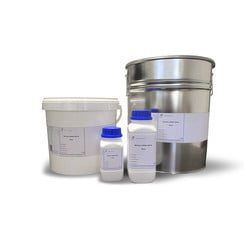You have no items in your shopping cart
Barium sulfate
Barium sulfate (or sulphate) is the inorganic compound with the chemical formula BaSO4. It is a white crystalline solid that is odorless and insoluble in water. It occurs as the mineral barite, which is the main commercial source of barium and materials prepared from it. The white opaque appearance and its high density are exploited in its main applications.
Uses
Drilling fluids
About 80% of the world's barium sulfate production, mostly purified mineral, is consumed as a component of oil well drilling fluid. It increases the density of the fluid, increasing the hydrostatic pressure in the well and reducing the chance of a blowout.
Radiocontrast agent
Barium sulfate in suspension is frequently used medically as a radiocontrast agent for X-ray imaging and other diagnostic procedures. It is most often used in imaging of the GI tract during what is colloquially known as a "barium meal". It is administered orally, or by enema, as a suspension of fine particles in a thick milk-like solution (often with sweetening and flavoring agents added). Although barium is a heavy metal, and its water-soluble compounds are often highly toxic, the low solubility of barium sulfate protects the patient from absorbing harmful amounts of the metal. Barium sulfate is also readily removed from the body, unlike Thorotrast, which it replaced. Due to the relatively high atomic number (Z = 56) of barium, its compounds absorb X-rays more strongly than compounds derived from lighter nuclei.
Pigment
The majority of synthetic barium sulfate is used as a component of white pigment for paints. In oil paint, barium sulfate is almost transparent, and is used as a filler or to modify consistency. One major manufacturer of artists' oil paint sells "permanent white" that contains a mixture of titanium white pigment (TiO2) and barium sulfate. The combination of barium sulfate and zinc sulfide (ZnS) is the inorganic pigment called lithopone. In photography it is used as a coating for certain photographic papers.
Paper brightener
A thin layer of barium sulfate called baryta is first coated on the base surface of most photographic paper to increase the reflectiveness of the image, with the first such paper introduced in 1884 in Germany. The light-sensitive silver halide emulsion is then coated over the baryta layer. The baryta coating limits the penetration of the emulsion into the fibers of the paper and makes the emulsion more even, resulting in more uniform blacks. (Further coatings may then be present for fixing and protection of the image.) More recently, baryta has been used to brighten papers intended for ink-jet printing.
Plastics filler
Barium sulfate is commonly used as a filler for plastics to increase the density of the polymer in vibrational mass damping applications. In polypropylene and polystyrene plastics, it is used as a filler in proportions up to 70%. It has an effect of increasing acid and alkali resistance and opacity.
Niche uses
Barium sulfate is used in soil testing. Tests for soil pH and other qualities of soil use colored indicators, and small particles (usually clay) from the soil can cloud the test mixture and make it hard to see the color of the indicator. Barium sulfate added to the mixture binds with these particles, making them heavier so they fall to the bottom, leaving a clearer solution.
In colorimetry, barium sulfate is used as a near-perfect diffuser when measuring light sources.
In metal casting, the moulds used are often coated with barium sulfate in order to prevent the molten metal from bonding with the mould.
It is also used in brake linings, anacoustic foams, powder coatings, and root canal filling.
Catalyst support
Barium sulfate is used as a catalyst support when selectively hydrogenating functional groups that are sensitive to overreduction. With a low surface area, the contact time of the substrate with the catalyst is shorter and thus selectivity is achieved. Palladium on barium sulfate is also used as a catalyst in the Rosenmund reduction.

